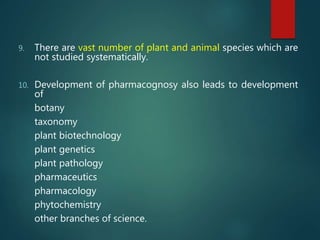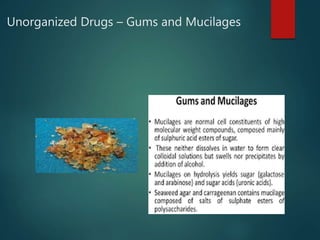Introduction_to_Pharmacognosy
- 1. Introduction to Pharmacognosy DR. SIDDHI UPADHYAY H.O.D. & ASSOCIATE PROFESSOR DEPT. OF PHARMACOGNOSY AND PHYTOCHEMISTRY SIGMA INSTITUTE OF PHARMACY
- 2. CONTENT 1. Definition of Pharmacognosy 2. History of Pharmacognosy 3. Scope of Pharmacognosy 4. Development of Pharmacognosy 5. Types of Crude Drugs – Organized & Unorganized Drugs 6. Sources of Crude Drugs – Plants, Animals, Marine & Tissue culture
- 4. Pharmacognosy is derived from twoGreek words, Pharmakon & Ginosco Pharmakon – means ‘drug’. Ginosco – means ‘to acquire knowledge of’. Means “to acquire the knowledge of drugs”. So, Pharmacognosy is a study of crude drugs that originate in the plants, animals, minerals and marines.
- 5. Pharmacognosy is broadly defined as the scientific and systematic study of the structural, physical, chemical and sensory characters of crude drugs of vegetable, animal, marine and mineral origin along with their history, method of cultivation, collection and preparation for the market.
- 6. Pharmacognosy word was coined by a German Scientist C.A. Seydler in 1815 during his work entitled “Analecta Pharmacognostica”. In 19th Century, “Materia Medica” was used to represent the subject “Pharmacognosy”.
- 8. SR. NO. NAME OF THE SCIENTIST WORK PERIOD OF THE SCIENTIST CONTRIBUTION OF SCIENTIST IN THE HISTORY OF THE SUBJECT PHARMACOGNOSY 1 Papyrus Ebers 16 th Century Prepared 60x1 ft. document containing information regarding 800 formula & 700 different drugs 2 Shen Nung 3000 BC Wrote a book named “Pen-t’sao” containing 365drugs, 1 for each day of the year 3 Charaka (Indian Scientist) 300 BC Made 50 group of 10 herbs, each of which according to him would suffice an ordinary physician’s need, He wrote a book “Charaka Samhita” 4 Sushruta (Indian Scientist) - Arranged 760 herbs in 7 distinct sets based on some of their common properties . He wrote a book “Sushruta Samhita” 5 Hippocrates 460-360 BC He is known as Father of Medicine
- 9. SR. NO . NAME OF THE SCIENTIST WORK PERIOD OF THE SCIENTIST CONTRIBUTION OF SCIENTIST IN THE HISTORY OF THE SUBJECT PHARMACOGNOSY 6 Aristotle 384-322 BC Research Work Contribution 7 Dioscorides 40-80 AD Research Work Contribution 8 Galen 131-200 AD He is First Pharmacist. He had a numbers of pain-relieving materials including “opium” in his Apothecary*. 9 Le’mery 1645-1715 He gave importance of extraction methods & reported Alcohol as an Extractant. 10 Swede Linnaeun 1707-1778 He was a Systematist. He classified plants and introduced the system of naming the plants known as “Binomial System”. *Apothecary = A person who prepare and sell medicine
- 10. SR. NO . NAME OF THE SCIENTIST WORK PERIOD OF THE SCIENTIST CONTRIBUTION OF SCIENTIST IN THE HISTORY OF THE SUBJECT PHARMACOGNOSY 11 William Withering 1785 He published an account of some of the medicinal properties of Digitalis leaves based on 10 years of experimentation by using percolation method. 12 Derosane (French Scientist) 1803 He isolated narcotine from opium 13 Serturner 1806 He isolated morphine from opium and recognise its role in relieving pain. 14 Pelletier (French Scientist) - He isolated strychnine from Ignatius beans and Nux vomica Seeds. 15 Stass & Otto 1852 They developed new extraction process for
- 11. SR. NO. NAME OF THE SCIENTIST WORK PERIOD OF THE SCIENTIST CONTRIBUTION OF SCIENTIST IN THE HISTORY OF THE SUBJECT PHARMACOGNOSY 16 Bentham & Hooker 1862-1863 They did development in plants classification system. 17 Posselt & Reimann 1828 They isolated nicotine from tobacco leaves 18 Neumann 1860 He isolated cocaine 19 G. Mandel 1865 He did important observation on plant hybrids. 20 Berg 1865 He published a book named “Anatomical Atlas of Crude Drugs”.
- 12. SR. NO . NAME OF THE SCIENTIST WORK PERIOD OF THE SCIENTIST CONTRIBUTION OF SCIENTIST IN THE HISTORY OF THE SUBJECT PHARMACOGNOSY 21 Hardy 1875 He isolated pilocarpine 22 Gerrad 1877 He isolated ouabain 23 A. W. Eichler 1883 He did development in plants classification system. 24 Nagai 1887 He isolated ephedrine 25 Engler & Prandtle 1887-1891 They did development in plants classification system 26 Kuersten 1891 He isolated podophyllotoxin 27 Greenish & Collin 1904 He compiled anatomical characters of several powdered drugs of great significance. He published a book named “An Atlas of Powdered Vegetable Drugs”.
- 14. 1. ACTION OF DRUGS The knowledge of the action of drugs can be utilized successfully when the identity , physical nature and chemical constituents of the drug are well known , and pharmacognosy supplies this information. Solubility Reactivity Stability Toxicity Dosage , availability And isolation , purification natural origin
- 15. 2. DRUG FORMULATION Formulation and actual preparation of a pharmaceutical product (pharmaceutics) are dependent on a number of properties; such as solubility, stability, reactivity, etc. of ingredients. This type of information on substances of natural origin is available to the pharmacist if he possesses a good knowledge of pharmacognosy.
- 16. 3. PRICE OF PHARMACEUTICAL PRODUCTS Price of pharmaceutical products containing natural substances is influenced by the methods of collection , drying , curing , and assaying of the ingredients , which are dealt with in pharmacognosy .
- 17. 4. ISOLATION OF PHYTOCHEMICALS ALKALOIDS : alkaloids are obtained from the plants of Belladonna , Hyocyamus , Rauwlofia . GLYCOSIDES : glycosides are obtained from the digitalis leaves MORPHINE : morphine and other alkaloids from opium plant .
- 18. 5. STRUCTURAL ACTIVITY RELATION SHIP Tubocurarine and Toxiferine from curare plant have muscle relaxant properties because of quaternary ammonium groups . The hypotensive and tranquilizing action of reserpine are due to the trimethoxy benzoic acid .
- 19. 6. DRUGS OBTAINED BY PARTIAL SYNTESIS Pharmacognosy plays important role in the synthesis of new drugs by the natural products. For example , Preparation of steroid hormones from diosgenin by acetolysis and oxidation and further preparation of cortisone by microbial reaction .
- 20. 7. NATURAL PROUCTS AS A MODEL Natural products are used as a model for the synthesis of new drugs ; MORPHINE : it is a model of a large group of potent drugs . COCAINE : it is a model for local anesthesia . ATROPINE : is a model for certain spasmolytics .
- 21. 8. DRUGS OF THERAPEUTIC USES It has a wide scope for the main element in providing us with the information about the dugs of main therapeutic uses such as alkaloids , steroids , antibiotics etc. And helps in the cultivation and collection of many medicinal plants. Helps in preparation of herbal formulation
- 22. 9. BIOSYNTHETIC PATHWAYS Biosyntheticpathways are of primary and secondary metabolites. Some of the important pathways are Calvin's cycle of photosynthesis. Shikimic acid pathway of aromatic compounds
- 24. 1. Pharmacognosy is important branch of pharmacy which is playing key role in new drug discovery and development by using natural products. Pharmacognosy has given many leads for new drug discovery and development. 2. It is an important link between modern medicine systems (allopathy) and traditional system of medicine. It is part medicinal system which is affordable as well as accessible to common man. As part of integrative system of medicine, pharmacognosy can help to increase effectiveness of modern medicine system.
- 25. 3. It is acting as bridge between pharmacology, medicinal chemistry and pharmacotherapeutics and also pharmaceutics. It also bridges pharmaceutics with other pharmacy subjects. 4. More than 60 percent of world population is still using natural product for their primary healthcare needs. Pharmacognosy can provide safe and effective drugs in combination with modern medicine system.
- 26. 5. Pharmacognosy includes knowledge about safe use of herbal drugs including toxicity, side effects, drug interaction; thereby increasing effectiveness of modern medicine. 6. Pharmacognosy is an important link between pharmacology and medicinal chemistry. As a result of rapid development of phytochemistry and pharmacological testing methods in recent years, new plant drugs are finding their way into medicine as purified phytochemicals, rather than in the form of traditional galenical preparations.
- 27. 7. Pharmacognosy is the base for development of novel medicines. Most of the compounds obtained from natural product serve as prototype or base for development of new drug which are more active and less toxic. 8. By means of pharmacognosy, natural products can be dispensed, formulated and manufactured in dosage forms acceptable to modern system of medicine.
- 28. 9. There are vast number of plant and animal species which are not studied systematically. 10. Development of pharmacognosy also leads to development of botany taxonomy plant biotechnology plant genetics plant pathology pharmaceutics pharmacology phytochemistry other branches of science.
- 29. Types of Crude Drugs – Organized & Unorganized Drugs
- 30. • Drugs are organized or unorganized. • Organized drugs are direct parts of the plants and consist of cellular tissues. • Unorganized drugs, even though prepared from plants, are not the direct parts of the plants and are prepared by some intermediary physical processes like incision, drying, or extraction with water and do not contain cellular tissue.
- 31. Difference between Organized and Unorganized drugs
- 32. Unorganized Drugs – Dried Latex
- 34. Unorganized Drugs – Dried Juices The juices are obtained from fleshy leaves (aloes) or from stems of the trees (kino). In all cases, incisions are made to respective part of the plant and juices coming out juice collected and dried. Example: Aloe
- 35. Unorganized Drugs – Dried Extracts Dried extract is a solid drug preparation that can be incorporated into tablets, coated tablets and capsules. In production, the drug is most exhaustively extracted with a solvent. Thereafter, the solvent used for extraction evaporates again and the solid residue is fed to a drying process. Dried extracts have a moisture content of max. 5%, however, they tend to attract moisture and thus clump together. Therefore, the dried extracts often contain additives such as maltodextrin, syrup, silica, etc..
- 36. Unorganized Drugs – Gums and Mucilages
- 37. Unorganized Drugs – Oleoresins(resins and gums)
- 38. Unorganized Drugs – oleo- gum-resin A solid plant exudation (as asafetida or myrrh) consisting of a mixture of volatile oil, gum, and resin.
- 39. Sources of Crude Drugs – Plants, Animals, Marine & Tissue culture
- 40. Plants as Sources of Crude Drugs SR. NO. PLANT PART TYPE OF DRUG EXAMPLES OF PLANT PART DRUGS 1 Leaves Organized Vinca, Vasaka 2 Roots Organized Rauwolfia, Ipecac 3 Stems Organized Ephedra 4 Rhizomes Organized Turmeric, Ginger 5 Flowers Organized Clove, Saffron 6 Fruits Organized Coriander, Fennel 7 Seeds Organized Nux-Vomica, Isapgol 8 Woods Organized Quassia, Sandalwood 9 Barks Organized Cinchona, Kurchi
- 41. SR. NO. PLANT PART TYPE OF DRUG EXAMPLES OF PLANT PART DRUGS 10 Entire drugs Organized Ephedra, Ergot 11 Dried lattices Un-organized Opium, Papain 12 Dried juices Un-organized Aloe vera, Red gum 13 Dried extracts Un-organized Gelatin, Agar 14 Gums & Mucilages Un-organized Acacia, Tragacanth 15 Resins & Resin combinations Un-organized Myrrh, Asafoetida
- 42. Animals as Sources of Crude Drugs SR. NO. ANIMAL NAME (Botanical Name) DRUG TYPE OF DRUGS 1 Cod Fish (Godus morrhua) Cod Liver Oil Organized 2 Hos (Sus scrofa) Lard Organized 3 Shark (Hyporian brevirostris) Shark Liver Oil Organized 4 Shark (Galeorhinus zyopterus) Shark Liver Oil Organized 5 Sheep (Ovis aries) Hydrous Wool Fat Un-organized
- 43. Marine as Sources of Crude Drugs SR. NO. MARINE ORGANISM (Botanical Name) ACTIVE CHEMICAL CONSTITUENT 1 Red Algae (Chondria opposiliclada) Cycloeudesmol 2 Annelida (Thelespus serosus) Tholpin
- 44. Tissue culture as Sources of Crude Drugs SR. NO. PLANTS THAT ARE CULTIVATED THROUGH TISSUE CULTURE 1 Rauwolfia serpentina 2 Dioscorea species 3 Nicotiana tobacum 4 Phaseolus vulgaris 5 Trichonederma viride SR. NO. PLANTS THAT ARE CULTIVATED THROUGH TISSUE CULTURE 6 Cassia angustifolia 7 Atropa belladonna 8 Coffea arabica 9 Digitalis lanata













































